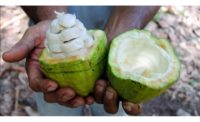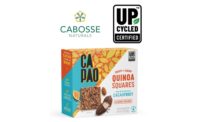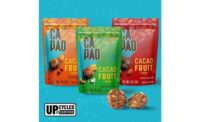Barry Callebaut subsidiary Cabosse Naturals has launched a free-flowing, 100% pure cacaofruit powder, a new ingredient which can replace refined sugar in food manufacturing.
In addition to the existing ingredient range of pulp, juice, and concentrate, cacaofruit powder enables consumers to experience a new taste and texture in confectionery and ice cream. Its launch also caters to growing consumer demand for products containing less refined sugar and ingredients which are kinder to the environment.
By using Cabosse Naturals’ upcycled cacaofruit ingredients in their applications, artisans, and brands are also able to apply for an Upcycled Certified mark on packaging—the world's first mark certifying upcycled food in products, enabling consumers to make an impact-informed purchase and help prevent food waste.
The most discarded fruit on the planet, cacaofruit contains a nutritious pulp, which surrounds its precious seeds, or beans, which are harvested and used in the manufacture of chocolate. The upcycled cacaofruit powder is obtained from this sweet, fruity pulp, which would otherwise go to waste, and is blended cocoa as a new carrier to produce a unique and delicious ingredient.
“This new powder brings the characteristic fresh fruitiness of the cacaofruit pulp to new creations and, thanks to its fruity taste and natural sweetness, it can replace refined sugar in fat-based fillings in confectionery and ice cream. It also brings a lovely taste and it is upcycled," says William Angleys, sales director, Cabosse Naturals.
Several innovative brands have launched products containing cacaofruit ingredients in partnership with Cabosse Naturals. Launches include BevCacao, a functional beverage which is made with Cabosse Naturals upcycled cacaofruit pulp and is sold online at Walmart, as well as Jeff de Bruges, leading chocolate franchise shop with over 473 in France and 50 shops across Europe.
The Barry Callebaut subsidiary expects new and exciting products containing cacaofruit powder to be launched in the months ahead.
The journey of the cacaofruit starts in farms in the tropical regions around the Equator. Once ripe, the cacaofruit is harvested by hand, cleaned and opened to remove the seeds from the fresh pulp; the seeds being used in the manufacture of chocolate. However, these seeds, or beans, represent only about 30% of the fruit, meaning that 70%—its pulp and peel—is generally discarded, which represents a tremendous waste.
Cabosse Naturals has worked for years to create an innovative and unprecedented upcycling supply chain to harness the natural richness of the largely forgotten cacaofruit.
The cacaofruit’s zesty signature flavor is refreshing and brings complex notes and natural sweetness to ingredients, which are very versatile and can be used in a number of ways, including in drinks, ice cream, dairy products, confectionery and snacks.
Cacaofruit facts:
- Preventing food waste is the single most effective solution to prevent global warming and cacaofruit is the most impactful fruit to fully upcycle.
- Around the world, about 30% of all food, 50% of all fruit and vegetables and 70% of all cacaofruit goes to waste yearly
- Annually, about 14 million tonnes of cacaofruit are harvested around the world.
- Up to 70% of the cacaofruit was previously thrown away—that’s as much as 10 million tonnes.
- If all harvested cacaofruit was used to its fullest, it would reduce the same amount of CO2 as planting 3.5 billion trees per year. That’s an area bigger than Texas and Kansas combined.




